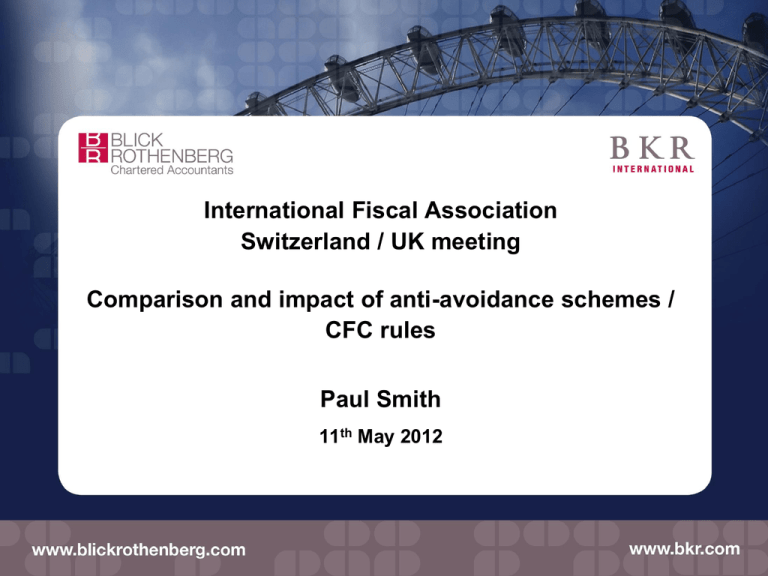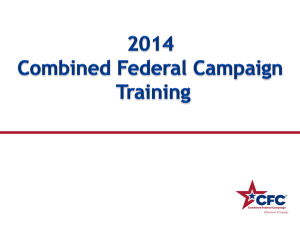Paul Smith - IFA-UK
advertisement

International Fiscal Association Switzerland / UK meeting Comparison and impact of anti-avoidance schemes / CFC rules Paul Smith 11th May 2012 IFA – Switzerland / UK meeting Comparison and impact of anti-avoidance schemes / CFC rules 1. UK 1. UK current – various anti-avoidance measures 2. UK future – GAAR 3. Treaty – anti-avoidance 2. Switzerland – anti-avoidance measures 3. UK CFC rules – a new “improved” regime UK anti-avoidance measures 1. Purposive interpretation of tax statutes 2. Specific anti-avoidance legislation / targeted anti-avoidance rules (“TAARs”) 3. Disclosure of Tax Avoidance Schemes (“DOTAS”) and the future? 1. General Anti-avoidance Rule (“GAAR”) 2. Reduced TAARs? 3. Simpler legislation? UK anti-avoidance measures – 1 Purposive interpretation of tax statutes 1. Pre Ramsay v IRC [1982] AC 300 – Literal interpretation of statute by UK Courts – If two interpretations – Courts erred in favour of taxpayer 2. Post Ramsay – Purposive interpretation of statute by UK Courts – Look beyond literal language to seek true meaning of a particular provision – Courts possibly “stretched” interpretation to thwart tax avoidance schemes – (uncertainty of taxation?) UK anti-avoidance measures – 2 Specific anti-avoidance legislation 1. Early example – section 28 FA 1960 – dividend stripping & bond washing provisions to stop the creation of tax losses where no economic loss arose 2. Targeted anti-avoidance rules (“TAARs”) – More than 300 in UK tax legislation – TAARs within specific anti-avoidance legislation as well as in their own right (e.g. draft UK CFC legislation) UK anti-avoidance measures – 3 Disclosure Of Tax Avoidance Schemes (“DOTAS”) 1. Introduced in Finance Act 2004 – For income tax (“IT”), corporation tax (“CT”) and capital gains tax (“CGT”) applied to employment or financial products – Separate rules applied to VAT 2. Extended – From August 2006 extended to include any tax arrangements relating to IT,CT or CGT. “Filters” replaced by “Hallmarks”. “In house” arrangements to be disclosed within 30 days rather than at tax return filing date – Extended to apply to SDLT (2005), NIC (2007), IHT (2007) General Anti-Avoidance Rule (“GAAR”) 1. In place in a number of regimes: Canada, Australia, New Zealand and Spain. Similar rules also introduced in France, Ireland and South Africa. Countries considering a GAAR include India and UK. 2. Last considered in UK in 1998, fully discussed and abandoned as its catch all nature MIGHT harm business planning and investment. Instead disclosure of tax avoidance schemes (“DOTAS”) was introduced as a “miniGAAR” GAAR dismissed? – yes but not really! 1. Jun 2010 – HM Treasury issues “Tax policy making: a new approach” – GAAR mentioned 2. Dec 2010 – Graham Aaronson QC asked to lead a study to establish whether a GAAR could be effective in UK – GAAR now being reconsidered in the light of an increasingly complex UK tax system 3. Mar 2011 – HM Treasury issues “Tackling Tax Avoidance” 4. Nov 2011 – GAAR report issued with recommendation to introduce a limited scope GAAR GAAR Advisory Committee Advisory Committee Aaronson (QC) Agreed Nolan (part time Judge ex S&M) Agreed Neutral Agreed Neutral Agreed Agreed Agreed Agreed Bartlett (BP plc) Agreed Freedman (Prof) Agreed Tiley (Prof) Agreed Hoffman (Judge) Neutral Henderson (Judge) Neutral GAAR Study - Conclusions 1. The most critical factor taken into account was whether introducing a GAAR might erode the attractiveness of the UK tax regime to business 2. The Advisory Committee concluded that a broad spectrum GAAR would not be beneficial to the UK because there was a real risk of undermining the ability of business and individuals to do sensible and responsible tax planning – which is entirely appropriate in a very complex tax regime such as the UK’s 3. A broad spectrum GAAR would need a comprehensive clearance system – too expensive! GAAR Study - Conclusions 4. A moderate GAAR would be beneficial: – It would deter contrived and artificial schemes – Level playing field with responsible tax planning enterprises – Reduces temptation of Judges to “stretch” the interpretation – Enables future legislation to be simply drafted – no TAARs – Future programme to reduce TAARs should be possible – No need for a comprehensive system of tax clearances for centre ground of responsible tax planning – Independent Advisory Committee should be a cost effective way to help identify outer limit of responsible tax planning – Help public debate on boundaries between acceptable and unacceptable behaviour GAAR Study - Conclusions 5. Safeguards to ensure centre ground of tax planning is protected: 1. Explicit protection for reasonable tax planning 2. Explicit protection for arrangements entered into without any intent to reduce tax 3. Burden of proof on HMRC to prove an arrangement is not reasonable tax planning 4. Advisory Panel to be established with relevant expertise and a majority of non-HMRC members 5. Right to refer to material even if not admissible in a Court 6. GAAR application to be authorised by senior HMRC officials GAAR Study - Conclusions 6. Concerns 1. Mission creep 2. Subsequent reduction in volume and complexity of specific anti-avoidance rules does not happen GAARs in other countries 1. Canada – Introduced in 1987 in response to Stubart case where Supreme Court rejected the general application of a business purpose test (broadly, following Ramsay) 2. Australia – Introduced against a background of highly literalist interpretation of tax statutes – i.e. the Canadian / Australian Courts had not adopted a purposive approach and they had no DOTAS arrangement in place. GAAR in the UK Current Court interpretation of tax statutes • Purposive interpretation still applying but • HMRC lost in Court of Appeal in SHIPS 2 case* because the prescriptive nature of the statutory rules in question prevented the Court from finding a purposive interpretation ____________ * Commissioners for Revenue & Customs v Mayes [2011] EWCA Civ 407 - SHIPS 2 was marketed by Matrix Tax Solutions and involved seven pre-ordained steps involving the purchase by a non-resident company of nonqualifying life assurance policies (AIG bonds) followed soon after by their partial surrender and withdrawal of funds. The arrangement was designed to produce allowable deductions from total income on disposal of the policies and capital sum allowable deductions in computing gains. GAAR in the UK Tax avoidance is firmly on the political agenda George Osborne “I’m going after the wealthy tax dodgers” Telegraph 10/04/12 George Osborne “ ‘shocked’ at level of tax avoidance among wealthy” Guardian 10/04/12 Treaty anti-avoidance 1. Anti-conduit provisions – dividend, interest and royalty articles “The provisions of this Article shall not apply in respect of any [interest] paid under, or as part of, a conduit arrangement.” Swiss / UK treaty - protocol of 26/06/07 effective 22/12/08 2. Capital gains extended scope “The provisions of paragraph 5 shall not affect the right of the UK to levy according to its law a tax chargeable in respect of gains from the alienation of any property on a person who is and has been at any time during the previous six fiscal years, a resident of the UK or on a person who is a resident of the UK at any time during the fiscal year in which the property is alienated.” Swiss / UK treaty - protocol of 26/06/07 effective 22/12/08 Treaty anti-avoidance 3. Holding companies “This convention shall not apply to holding companies entitled to any special tax benefit under the Luxembourg laws of 31st July 1929 or 27th December 1937 or any similar law …” Article 30 Luxembourg / UK tax treaty 4. Limitation of relief / remittance basis “Where … any income … is subject to tax by reference to the amount thereof which is remitted to or received in the other Contracting State and not by reference to the full amount thereof, then the relief to be allowed under this Agreement in the first – mentioned Contracting State shall apply only to so much of the income as is taxed in the other Contracting State.” Article 24 Singapore / UK tax treaty Treaty anti-avoidance 5. Limitation on benefits Need to be a “qualified person” to obtain treaty benefits; or Satisfy a “derivative benefits” test – certain categories of income may qualify for treaty benefits; or Satisfy the “active trade or business test” – certain categories of income may also qualify for treaty benefit s; or Apply to Competent Authority Article 23 UK / US tax treaty International Fiscal Association Switzerland / UK meeting CFC rules Paul Smith 11th May 2012 UK CFC Reforms What: Reform of UK controlled foreign companies (CFCs) rules + extending CFC rules to foreign branches When: Views of business sought in 2006 Discussion document issued by Government in June 2007 Draft legislation issued 6 Dec 2011 (updated 31 Jan 2012 & 29 Feb 2012) Finance Bill 2012 issued 29 Mar 2012 Effective: Proposed to be for accounting periods starting 1 Jan 2013 Why: To make the UK’s tax system competitive Difficulties: Protecting tax revenues against a diversion of profits from the UK, Government’s need to raise and collect taxes and to comply with EU law Result: Very complex legislation – 98 pages and small print UK CFC Reforms – the new rules Agenda 1.Full exemptions: these are entity level exemptions 2.Exemption for specific profits 3.CFC charge Gateway New CFC rules - full exemptions (entity level exemptions) Temporary (exempt) period exemption (Chapter 10): – A 12 months exemption period on, say, buying a new subsidiary provided that the subsidiary is, essentially, restructured within 12 months so that no CFC charge would arise for future periods Excluded territories exemption (Chapter 11): – CFCs resident in specified territories (broadly intended to be those with a headline tax rate of more than 75% of UK CT rate) will be exempt provided that their total income within certain categories (generally income that is exempt or subject to a reduced rate of tax) does not exceed 10% of the company’s pre-tax profits for the accounting period (or £50,000 if greater) – But exemption not be available where significant IP has been transferred to the CFC from the UK in the prior 6 years New CFC rules - full exemptions (entity level exemptions) Low profits exemption (Chapter 12): – accounting profits < £50,000 for an accounting period – accounting profits < £500,000 and < £50,000 of non-trading income Low profit margin exemption (Chapter 13): – accounting profits do not exceed 10% of its relevant operating expenditure Tax exemption (Chapter 14): – Local tax paid is at least 75% of the corresponding UK tax that would be payable - similar to the lower level of tax test used to define a CFC under the current rules New CFC rules – exemption of specific profits 1. Capital gains [s371VD(2)(c)] 2. Property business profits [s371VD(2)(b)] 3. Business profits - except those passing through the “CFC charge Gateway” 4. Trading finance profits - except those passing through the “CFC charge Gateway” 5. Non-trading finance profits – ¾ exempt if tax election / claim made [Chapter 9] 6. Incidental (< 5%) non-trading finance income [s371CC & s371CD] 7. Group treasury company finance profits – ¾ exempt if elect to treat as nontrading and elect for partial exemption [s371CE(2) & Chapter 9] CFC charge Gateway A CFC’s chargeable profits are defined to be so much of its assumed total profits as pass through the CFC charge Gateway – so pass through the Gateway at your peril! [s371BA] CFC charge Gateway Apportionment of CFC’s profits to its UK parent will only arise where the CFC has: 1. For General Business (non-financial) profits (Chapter 4): 1. Tax purpose – UK tax reduction as a main purpose and expects CFC profits to be bigger, or a person’s tax liability to be reduced. 2. UK activities – i.e. control & management of CFC’s assets/risks is carried on to a significant extent in the UK; 3. Capability & commercial effectiveness – CFC has UK managed assets / risks and it could not manage them on its own / by outsourcing to third party; or 2. Non-trading finance income (Chapter 5) [n.b. 5% deminimis rule & 75% exemption] 3. Trading finance income with funds derived from UK connected capital contributions (Chapter 6) 4. Other specific types of income arising to certain companies e.g. insurance / banking (Chapters 7-8) CFC charge Gateway General Business (non-financial / non-property) profits Re-calculate CFC profits excluding UK significant people function (“SPF”) profits • If no UK SPFs No CFC charge • If some UK SPFs CFC profits attributable to UK SPFs pass through the CFC charge Gateway and may be apportioned and taxed in UK Profits passing through the CFC charge Gateway are those left out of the recalculated CFC profits • Calculate profits by following OECD Report approach • But exclude all profits where: 1. 2. 3. • UK activities are a minority of total activities [s371DC]; The separation of assets or risks from activity does not give rise to substantial non-tax value [s371DD]; or Similar arrangements would be put in place if the UK SPFs were replaced by independent companies [s371DE]. And exclude trading profits where five conditions (next slide) are satisfied CFC charge Gateway Trading profits exclusion Trading profits – five conditions: Business premises condition: CFC must have premises in its territory of residence where the CFCs business is carried on. Income condition: No more than 20% of the CFC trading income is from the UK Management expenditure condition: No more than 20% of the CFCs management expenditure relates to UK staff. IP condition: IP that has been transferred by a UK related party to the CFC within the past 6 years has not resulted in a significant reduction in value to that UK related party. Export of goods condition: no more than 20% of the CFCs trading income arises from goods exported from the UK. Effectively replaces the old exempt activities test (available effectively where CFC carried on trading activities with third parties outside the UK) CFC charge Gateway Trading finance profits Trading finance profits – If the CFC has trading finance profits and has funds derived directly or indirectly from UK connected capital contributions, then the CFC’s profits pass the CFC charge Gateway and are potentially within the scope of a CFC apportionment. [s371CE] – If “free capital” of CFC (contributed by UK connected capital contributions) does not exceeds arm’s length “free capital” then the profits of the CFC do not pass through the CFC charge Gateway and are not within the scope of the CFC regime. [Chapter 6 – step 3] – Group Treasury companies can opt to be treated if their trading finance profits were non-trading finance profits – and therefore entitled to elect for the partial exemption to apply taxing only 25% of the its profits New CFC rules - Finance Company Exemptions Finance Company Partial Exemption (“FCPE”): – Applies to non-trading finance companies (and Treasury companies if an election has been made) – 3/4 of CFCs “qualifying loan relationship profits” are excluded from the CFC charge. – “Qualifying loan relationships” include loans where the debtor is a company connected with the CFC which obtains a UK tax deduction. – CFC to have appropriate business premises in its territory of residence. – Must make an election CFC - Comparison - old and new rules Now Future Lower level of tax 75% UK rate 75% UK rate De minimis profits £200,000 £500k and non-trading income < £50k Control 50% and 40% tests same plus FRS2 control Exempt Activities Test Gross receipts<50% from UK/group N/A Trading Income Exclusion N/A ≤ 20% from UK of income / mgt/ exports to + no IP transferred from UK for 6 yrs Excluded Territories Yes, 90% local source income req'd Yes, similar but excludes Singapore + has an IP condition Motive Test Yes, but used sparingly N/A Gateway Test N/A Need SPFs to be non-UK Finance Co Partial exemption N/A ¼ profits apportioned to UK Low profit margin exemption N/A Profits ≤ 10% operating spend Dual resident (UK inc, treaty, non UK resident) UK resident Foreign resident Foreign branches not CFCs CFC rules apply New CFC rules – Final thoughts Foreign Finance Companies: A very welcomed change and puts the UK on a similar footing to US based groups when financing overseas expansion Intangible Property: The rules are still very draconian in relation to IP. The UK CFC rules are aimed at dissuading groups from transferring IP abroad. There are other tax incentives for attracting IP to the UK (mainly R&D credits and from 2013 the patent box rules) but they do not provide incentives for acquiring or developing brands and trademarks in the UK. Simplification: Not really. 98 pages of legislation have replaced 64 pages of existing legislation. Some new provisions were required (e.g. finance company partial exemption rules) and we will become familiar with the new rules in due course. TAARs: I counted 10 TAARs within the new legislation. This is not consistent with the introduction of a GAAR. Contact us E: paul.smith@blickrothenberg.com T: +44 20 7544 8823 12 York Gate, Regent’s Park, London NW1 4QS, United Kingdom Telephone: +44 (0)20 7486 0111, Fax: +44 (0)20 7935 6852






